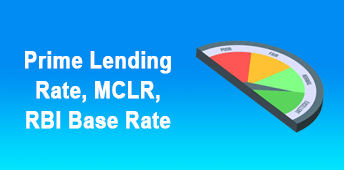

14 sept, 2023

Financial institutions adhere to three crucial internal benchmarks, namely Prime Lending Rate (PLR), Marginal Cost of Funds-based Lending Rate (MCLR), and RBI Base Rate, when determining interest rates. Let’s dig into the details of these benchmarks and explore their impacts on the rates offered by lenders.
What Is PLR (Prime Lending Rate)?
Introduced in April 2003, the Benchmark Prime Lending Rate (BPLR) policy aimed to determine the interest charged by commercial banks to their most creditworthy customers. However, transparency issues arose due to the absence of a fixed formula for estimating the prime rate. This lack of transparency hindered the alignment of repo rates with interest rates, impacting the balance between growth and inflation. In response to the shortcomings of the BPLR policy, the RBI launched the Base Rate Policy in July 2010. The Benchmark Prime Lending Rate (BPLR) is now 14.95% per year starting from September 15, 2023. Additionally, The mortgage market is significantly influenced by changes in interest rates. Elevated interest rates result in increased financing costs across various segments of the real estate market, leading to an impact of interest rate on mortgage.
Prime Lending Interest Rate:
| Date | BPLR (%) |
|---|---|
| 15-03-2023 | 14.85 |
| 15-12-2022 | 14.15 |
| 15-09-2022 | 13.45 |
| 15-06-2022 | 12.75 |
| 15-03-2022 | 12.30 |
| 15-12-2021 | 12.30 |
| 15-09-2021 | 12.20 |
| 15-06-2021 | 12.25 |
| 10-03-2021 | 12.15 |
| 10-12-2020 | 12.05 |
What is Base Rate?
Similar to the prime rate concept, the Base Rate Policy considered a customer's creditworthiness for determining the interest rate, with the RBI prescribing a formula for Base Rate calculation. Despite this improvement, transparency remained a challenge, as no permanent formula was provided to banks. The RBI's Base rate demonstrated minimal impact from changing repo rates on the interest rates of commercial banks.
The base rate of loan, set by the RBI, is the minimum interest rate for Indian banks to lend to customers. Banks cannot offer loans below this rate, except under government mandates.
What Is MCLR (Marginal Cost of Funds-based Lending Rate?
Introduced in April 2016, MCLR presented a renewed approach to internal benchmarking. The RBI prescribed a fixed formula for MCLR calculation, enhancing transparency and addressing the limitations of the Base Rate and Prime Lending Rate. MCLR is applicable only to commercial banks, excluding NBFCs. It applies to both floating and fixed interest rates (up to 3 years), with the aim of providing a more transparent and adaptable benchmark.
How MCLR, PLR, and Base Rates Work:
Banks publish MCLR for various tenors, ranging from one day to a year. Changes in the Repo rate may not immediately reflect in EMIs due to these reset periods. MCLR factors in the costs of new deposits, with the RBI specifying that 92% of the marginal cost of borrowings plus an 8% return on net worth equals the marginal cost of funds. Borrowings include rates on short-term, long-term, and foreign currency borrowings, with considerations for negative carry on Cash Reserve Ratio(CRR) due to the return being less than the cost of funds.
Differences between an PLR, MCLR rate and the base rate
MCLR (Marginal Cost of Funds Based Lending Rate): Minimum rate charged by financial institutions on loans, linked to current cost of funds.
PLR (Benchmark Prime Lending Rate): Interest rate charged by banks before the introduction of MCLR, calculated based on the average cost of funds.
Base Rate: Minimum lending rate, determined significantly by the average cost of funds, replaced by MCLR in 2016.
In conclusion, grasping the dynamics of PLR, MCLR, and RBI Base Rate is crucial for understanding how interest rates are shaped. This blog has highlighted the significant role these benchmarks play, particularly the transparency improvements brought by MCLR. Armed with this knowledge, borrowers can make informed decisions in the dynamic financial landscape. Stay informed, stay empowered.
FAQ: Understanding Key Concepts in Indian Banking
1. What is Prime Lending Rate in India?
The Prime Lending Rate (PLR) in India refers to the interest rate that commercial banks charge their creditworthy customers. It serves as an internal benchmark for setting interest rates on various loans.
2. How Base Rate is Calculated?
The Base Rate in India is calculated based on the average cost of funds for banks. It represents the minimum lending rate below which banks cannot lend. The base rate is periodically reviewed by banks, typically on a quarterly basis.
3. Is the MCLR Rate the Same for All Banks Across India?
No, the Marginal Cost of Funds Based Lending Rate (MCLR) is not the same for all banks across India. Each bank calculates its MCLR based on its marginal cost of funds, operating costs, and other factors. As a result, MCLR rates may vary between different banks.
4. Are MCLR Loans More Transparent than Base Rate Loans?
Yes, MCLR loans are generally considered more transparent than Base Rate loans. MCLR takes into account the marginal cost of funds, making it more responsive to changes in market conditions. This enhances transparency in determining lending rates.
5. Does Interest Rate Hike Affect Existing Loans?
Yes, an interest rate hike can affect existing loans. For loans with floating interest rates, such as those linked to MCLR or other benchmark rates, an increase in the benchmark rate may lead to higher interest rates on existing loans. However, fixed-rate loans remain unaffected by such changes for the agreed-upon duration.